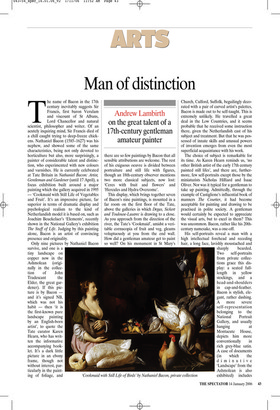ARTS
Man of distinction
Andrew Lambirth on the great talent of a 17th-century gentleman amateur painter
The name of Bacon in the 17th century inevitably suggests Sir Francis, first baron Verulam and viscount of St Albans, Lord Chancellor and natural scientist, philosopher and writer. Of an acutely inquiring mind, Sir Francis died of a chill caught trying to deep-freeze chickens. Nathaniel Bacon (1585â1627) was his nephew, and showed some of the same characteristics, being not only devoted to horticulture but also, more surprisingly, a painter of considerable talent and distinction, who experimented with new colours and varnishes. He is currently celebrated at Tate Britain in Nathaniel Bacon: Artist, Gentleman and Gardener (until 17 April), a focus exhibition built around a major painting which the gallery acquired in 1995 â âCookmaid with Still Life of Vegetables and Fruitâ. Itâs an impressive picture, far superior in terms of dramatic display and psychological realism to the kind of Netherlandish model it is based on, such as Joachim Beuckelaerâs âElementsâ, recently shown in the National Galleryâs exhibition The Stuff of Life. Judging by this painting alone, Bacon is an artist of convincing presence and originality.
Tradescant the Elder, the great gardener). If this picture is by Bacon and itâs signed NB, which was not his habit â then âit is the first-known pure landscape painting by an English-born artistâ, to quote the Tate curator Karen Hearn, who has written the informative accompanying booklet. Itâs a dark little picture in an ebony frame, though not without interest, particularly in the painting of foliage, and there are so few paintings by Bacon that all sensible attributions are welcome. The rest of his exiguous oeuvre is divided between portraiture and still life with figures, though an 18th-century observer mentions two more classical subjects, now lost: âCeres with fruit and flowersâ and âHercules and Hydra Overcomeâ.
This display, which brings together seven of Baconâs nine paintings, is mounted in a far room on the first floor of the Tate, above the galleries in which Degas, Sickert and Toulouse-Lautrec is drawing to a close. As you approach from the direction of the river, the Tateâs âCookmaidâ, amidst a veritable cornucopia of fruit and veg, gleams voluptuously at you from the end wall. How did a gentleman amateur get to paint so well? On his monument in St Maryâs Church, Culford, Suffolk, beguilingly decorated with a pair of carved artistâs palettes, Bacon is made out to be self-taught. This is extremely unlikely. He travelled a great deal in the Low Countries, and it seems probable that he received some instruction there, given the Netherlandish cast of his subject and treatment. But that he was possessed of innate skills and unusual powers of invention emerges from even the most superficial acquaintance with his work.
The choice of subject is remarkable for its time. As Karen Hearn reminds us, âno other British artist of the early 17th century painted still lifesâ, and there are, furthermore, few self-portraits except those by the miniaturists Nicholas Hilliard and Isaac Oliver. Nor was it typical for a gentleman to take up painting. Admittedly, through the example of Castiglioneâs influential book of manners The Courtier, it had become acceptable for painting and drawing to be practised in polite society. A gentleman would certainly be expected to appreciate the visual arts, but to excel in them? This was uncommon. Bacon, rather like his 20thcentury namesake, was a one-off.
His self-portraits reveal a man with a high intellectual forehead and receding hair, a long face, lavishly moustached and sharply bearded. Two self-portraits from private collections grace this display: a seated fulllength in yellow stockings, and a head-and-shoulders in cap-and-feather. Bacon is stylish, elegant, rather dashing. A more severe self-representation belonging to the National Portrait Gallery, and usually hanging at Montacute House, depicts him more conventionally in rich grey-blue satin. A case of documents (in which the diminutive âLandscapeâ from the Ashmolean is also exhibited) includes two letters to his wife Jane, both beginning âSweet Hartâ. A portrait of a lady on the other side of the room is often described as Baconâs wife, though there is no hard evidence to support this. She is seen in heavily accented profile, in a more mannered and traditional pose, though the patterning of robe and lace is finely done.
The show is really stolen by the Tateâs painting. There is another version of the same subject on the opposite wall, a strange composition of live and dead birds, arranged around another handsome and dĂ©colletĂ© cookmaid, with the shadowy figure of a huntsman in the background. Despite some fine passages of plumage the swan is magnificent, and the heap of small birds, including nuthatch, bullfinch and great tit â this painting doesnât have the sweep or vision of its opposite number. âCookmaid with Still Life of Vegetables and Fruitâ is a vast and complex canvas of meticulously observed detail, as befits a noted horticulturalist. It ranges from exotic melons (grown in Baconâs own garden) to quinces, marrows, runner beans and white turnips, with a great flowering of cabbages and globe artichokes on the right. Thereâs also a closely observed garland of wild flowers from a hayfield on the wall above the maid. She is notable for the unusual extent of her exposed cleavage, indicating a sensuality and promise of fruition confirmed by the swollen melon clasped to her, suggesting a swollen belly. Itâs a powerful painting bursting with life: a refreshment to the spirit in this pessimistic age.















































 Previous page
Previous page